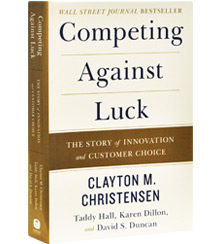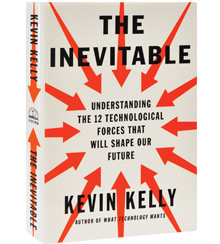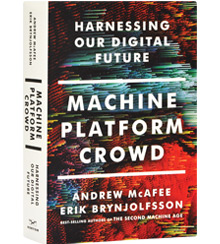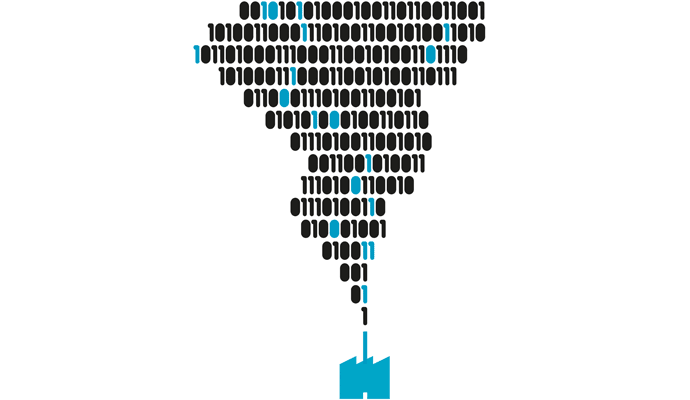Best Business Books 2017: Innovation
The Platform Competition
Clayton M. Christensen, Taddy Hall, Karen Dillon, and David S. Duncan
Competing against Luck: The Story of Innovation and Customer Choice (HarperBusiness, 2016)
Kevin Kelly
The Inevitable: Understanding the 12 Technological Forces That Will Shape Our Future (Viking, 2016)
Andrew McAfee and Erik Brynjolfsson
Machine, Platform, Crowd: Harnessing Our Digital Future (Norton, 2017)
*A TOP SHELF PICK
Innovation is an obsession. Companies spend hundreds of billions of dollars every year on R&D. Yet studies find little correlation between how much a company spends on R&D and its financial performance. Most products fail to make it past two years. And even in this time of rapid technological change, the difference between success and failure in innovation seems, if anything, more random than ever. So it’s not surprising that the year’s best business books on technology and innovation promise to discern the order beneath the chaos, and to make building a new product or service something more than taking a shot in the dark.
In Competing against Luck: The Story of Innovation and Customer Choice, Harvard Business School professor Clayton M. Christensen and his coauthors (Taddy Hall, Karen Dillon, and David S. Duncan) start with the assumption that at most companies, innovation is “a hit-or-miss process,” and they want to change it. Christensen’s 1995 book, The Innovator’s Dilemma, in which he coined the term disruptive innovation, was a theory of why dominant companies fail to innovate. In his new work, Christensen lays out a theory of what real innovation requires, one that he terms Jobs Theory.
Jobs Theory rests on a deceptively simple concept: Customers aren’t really interested in products and services in and of themselves. Instead, they buy them to solve a problem — or, in Christensen’s parlance, to do a job. Successful innovation, then, demands identifying exactly what that job is, and offering something that will help. Competing against Luck discusses five different routes to identifying the jobs that customers need help with — including looking at the jobs you yourself want to do, and looking at what customers are trying desperately to avoid doing. But the real key is a focus on context and circumstance.
Jobs Theory is a well-developed articulation of legendary marketing guru Theodore Levitt’s famous line (which he attributed to an advertiser named Leo McGivena), “Customers don’t want to buy a quarter-inch drill bit. They want a quarter-inch hole.” But Christensen says companies should ask, “What do customers want a hole in the wall for?” To answer this question, companies must uncover a rich and fully developed definition of what customers seek that goes beyond the classic market research into customer needs, engaging with the social and emotional dimensions of why customers purchase products and services. One of the most compelling sections of Competing against Luck is a careful dissection of the complex thought process a buyer went through while taking six months to decide to replace his mattress.
One interesting aspect of Christensen’s theory is that many consumer problems have a range of plausible solutions. Jobs Theory also inverts a conventional model of innovation: Instead of building a product and then figuring out how to sell it to consumers, you start with the consumers. That helps avoid the problem of an overemphasis on features for features’ sake, and the tendency of tech products, in particular, to succumb to feature creep as companies add more and more features to their products simply because they can.
Christensen makes a case that you can turn his theory into a systematic, rigorous process for driving innovation. But the leap from identifying a job to helping consumers do that job is obviously a huge one, and even identifying jobs seems harder than Christensen makes it out to be. Still, Jobs Theory offers an essential insight, which is that successful products are, in some sense, services. Corporations are already coming to terms with this reality, in part because of digitization. That’s why PwC has projected that R&D spending on products will have fallen 19 percent by 2020. Christensen’s book provides an intellectual framework for understanding that shift, and in the process helps explain why it will, if anything, accelerate.
Technological Futurism
On the surface, it’s hard to imagine a book less like Competing against Luck than futurist Kevin Kelly’s The Inevitable: Understanding the 12 Technological Forces That Will Shape Our Future. Where Christensen’s book is resolutely concrete and is replete with such homely examples of innovation as mattresses and milkshakes, Kelly’s book is — like most of his previous works — oracular in tone, riddled with high-flying sentences such as “People of the Book favor solutions by laws, while People of the Screen favor technology as a solution to all problems.” Kelly’s job title is senior maverick at Wired, and what he’s written here is a quintessential work of technological futurism, laying out 12 broad trends that will play a crucial role in shaping the future. Yet for all of the airy pronouncements, The Inevitable remains usefully tethered, at least most of the time, to reality; its real focus is the way humans use and will use technology in an always-on, always-connected world where devices are increasingly intelligent and increasingly networked. Kelly’s trends are all in the form of verbs — flowing, filtering, sharing, and so on. Although a bit of a shtick, the framework embodies Kelly’s view of where society is going: Processes are ultimately more important than products, even as products themselves are becoming processes.
The rise of artificial intelligence, the cognification of our surroundings (such that the physical world will respond and adapt to our needs and desires), the replacement of ownership by access (or the “Spotification” of the world), the tendency for individuals to self-track and to be tracked: These things are, in Kelly’s mind, inevitable. As the flood of information and data continues to rise, methods of filtering and organizing that flood will be more essential and more valuable. Consumption, particularly of information and entertainment, will become more active and dialogic. Our experience of the world will, in large part, be mediated through screens.
Because Kelly views these developments as inevitable, he says comparatively little about companies or entrepreneurs, and how they are supposed to bring this glorious future about. In that sense, his futurism has something in common with Marxist theory: Innovators almost seem to be mere vehicles, driven by the deeper forces of history. What’s valuable about The Inevitable, from a business perspective, is less what it says about how to innovate, and more what it says about where to innovate.
Kevin Kelly’s specific predictions often seem to reflect the kind of future someone like Kevin Kelly would like to live in.
There’s something exhilarating about Kelly’s optimism — no dystopian view of AI or the robot apocalypse for him. At the same time, he often treats any new technology as necessarily worth using, even when it doesn’t appear to represent much of an improvement over what we use today. He talks about how we’ll screen bowls to see if they’re clean from the dishwasher — is that a meaningful improvement from just looking at the bowl to see if it’s clean?
Kelly’s specific predictions often seem to reflect the kind of future someone like Kevin Kelly would like to live in. And in that, they may tell us less about the future than about Kelly himself. His macro view of the future, though, offers a convincing, and rigorous, picture of how technologies that we can see today will have a profound effect on our tomorrow. And that makes The Inevitable an essential text in thinking about how to take advantage of — and simply prepare for — the transformation of everyday life.
Platform News
If Competing against Luck is a classic work of business theory and The Inevitable is an inspiring ride into the future, Andrew McAfee and Erik Brynjolfsson’s Machine, Platform, Crowd: Harnessing Our Digital Future, the best business book of the year on technology and innovation, is an insightful and powerful blend of the two. McAfee and Brynjolfsson, both of MIT’s Sloan School of Management, became gurus of the digital era with their seminal book, The Second Machine Age (Norton, 2014), in which they argued that we were on the cusp of nothing less than a new industrial revolution. And although they were relatively optimistic about the long-term implications of that revolution, they also argued that in the short term, the impact would be wrenching, as new technologies decimated old job categories and threw millions out of work.
Clearly, in specific industries, digitization, the rise of AI, and the growing ability to tap the crowd are creating a host of new opportunities — and posing a new set of challenges. Machine, Platform, Crowd is McAfee and Brynjolfsson’s guidebook to this new world, focusing concretely on how organizations can best leverage the new tools the digital age offers. And its real subject is innovation in the broadest sense: not just innovations that bring new products and services to market, but also innovations in the way we make decisions and solve problems, in the way we collaborate, and in the way we organize work.
The book focuses on three shifts: from humans to machines, from products to platforms, and from the core to the crowd. Some of the book will be familiar to anyone who’s paid a little attention to the digital economy: It’s hardly a revelation, after all, that platforms have become central to the tech economy. But the authors’ discussion of the economics of platforms and how platform companies price their services is nonetheless fascinating. And they raise an especially interesting question: If so-called sharing platforms end up massively increasing the degree to which existing assets, such as cars, are shared (thereby reducing the number of cars that need to be individually owned), what happens to the companies that make the cars, and that have built entire businesses around the idea of individuals owning them?
Even stronger is the book’s analysis of how machine learning is changing the way companies not only analyze data but also make decisions. As the sheer amount of data that machines can now analyze has grown (thanks to the Internet), so too has the value of machine learning. It’s not just that patterns become more robust (and more significant) the bigger the sample you’re looking at. It’s also that the more data you give machines, the better they become at learning. If you want computers to be able to recognize pictures of a cat (something that was beyond them not very long ago), showing them millions of tagged cat pictures is a great way to do it.
McAfee and Brynjolfsson argue that machine learning can be used to, in effect, make decisions. They emphasize that algorithms are a good way of avoiding the biases that we know plague human decision makers. And a host of studies, dating back decades, show that algorithms can outperform human experts in a wide range of fields. Rather than continue with a decision-making model that ultimately boils down, in their words, to the highest paid person’s opinion (or HiPPO), companies should outsource a big chunk of the work of analysis, evaluation, and prediction to the machines. And although Machine, Platform, Crowd may overstate just how powerful machine learning has become and understate the organizational hurdles to going all in on algorithms, the book does an excellent job of showing how technological innovation is changing the way decisions are made.
Technology has made it far easier for companies to appeal to what McAfee and Brynjolfsson call the crowd. Although more suggestive than definitive, this section of their book makes a convincing case that companies that open themselves up to working with people outside the company (including customers and suppliers) can radically improve performance and drive innovation. In such companies as Quantopian, which is trying to build an investment tool by tapping the collective wisdom of traders; GE, which has used customers to help generate new products; and Topcoder, which provides companies access to coders around the world, the crowd is increasingly influential. People have been talking about the potential virtues of tapping the wisdom and work of the crowd for almost two decades. But its moment seems to have arrived.
Machine, Platform, Crowd is, then, an invaluable look at the impact of new technologies. But beneath all the concrete problems it raises, an intriguing question lies at the heart of the book: Given the rise of algorithmic decision making, the ability to outsource tasks to the crowd, and such technologies as blockchain, will the corporation as we know it become obsolete? As transaction costs fall, after all, the reasons to put everything under one corporate roof become less important, and it should become easier for groups of people to come together (virtually) to solve a problem without bosses or formal hierarchies.
And yet, as McAfee and Brynjolfsson argue, big companies don’t seem to be on their way out. Instead, by some measures, they’re more powerful than ever — especially in the tech world. And the companies that have been most successful at trying to drive new technologies also tend to look a lot like traditional companies.
So what gives? Some of these apparent contradictions have to do with the predictability and efficiency of having everyone connected to the same organization — which also makes it easier to obtain long-term commitments to new projects. But what’s also essential, Machine, Platform, Crowd argues, is that management matters and management creates value — from the CEO down to the much-maligned middle manager. That’s because if you want to get things done, leadership still matters. Organization still matters. And helping people work together smoothly and efficiently still matters.
This doesn’t mean that companies will go back to the traditional top-down, command-and-control model. On the contrary, McAfee and Brynjolfsson find, the best managers tend to be egalitarian — they listen to and take seriously ideas from people throughout the organization. And they also tend to be cognizant of their own decision-making limitations, open to using machines and crowds in helping inform their choices, and transparent in the way they share information. But their core job — managing people — is still much the same. Even as the world around it changes, the company, it turns out, is an innovation that endures.
Reprint No. 17409
Author profile:
- James Surowiecki writes the “Financial Page” column in the New Yorker. He is the author of The Wisdom of Crowds: Why the Many Are Smarter Than the Few and How Collective Wisdom Shapes Business, Economies, Societies, and Nations (Doubleday, 2004).







